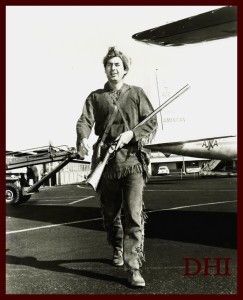ON THE STUDIO AFTER CROCKETT
“After I was at the Studio for two years, I still wasn’t making very much money. I had a chance meeting with Ray Stark, who was a big agent and I decided that I would let him be my agent. Ray went into the Studio, and raised my salary. From then on the contract was no longer with Walt, but with the Studio, and it was a new seven-year contract.
“I left the Studio two years later because we were in a disagreement. I could never figure out why we couldn’t work out our disagreement. And I think I finally understood it, maybe just today, that when I was under contract to Walt he was calling the shots. But when Ray Stark came in and renegotiated the contract, Walt, I think, felt a little less interested in my well-being. It was a distancing of the relationship, I think, in his mind. In my mind, it was a natural progression–you know, if they were willing to pay me this additional money I must be entitled to it.
“They wanted me to do a very small part in Tonka, like five minutes of film and a voice-over, and then give me second billing to a young actor who I had never heard of. And I said I didn’t agree with that. I didn’t have enough of a part to be co-starred, much less in second billing, and I wasn’t comfortable with it. I didn’t think it would be good for me career-wise. So, as a result, I left the Studio, and he tore up the contract. And that’s the way I left.”
ON LEAVING THE STUDIO
“I felt that it was [on] bad terms. I don’t think that anybody particularly felt good about it. I think I resented it. I felt that I’d worked very hard. Maybe I wasn’t mature enough to understand all the dynamics at the time. But I also felt that I was correct. The public was going to be lured into that film, in part, by the name and I wasn’t in it. And it was a part of the disintegration of what I’d hoped to be a career that would go beyond Disney, when in fact what I didn’t understand for many years, Paul, was that there I was, a young man that wanted to do action films. I wanted to follow in the footsteps of people that I admired like Gary Cooper, John Wayne, Henry Fonda, Gregory Peck, and Jimmy Stewart. And guess what? They were all available for films. Those guys were my competition in a declining film production schedule. I thought I’d failed. And it took me a long time to figure out, ‘Hey, I’m not a failure!’ It was the times and conditions.”
“NBC had an affiliate dinner–and of course Disney was still on Sunday nights on NBC. Marcy and I were standing over on one side of the room talking to some people, and I didn’t know that Walt and Lilly were in the room at all. I felt somebody tap me on the shoulder, and it was Walt. He came over and he said ‘How are you?’ He said, ‘I just wanted to wish you well on your new television venture.’ I said ‘Well, thank you very much. Is Mrs. Disney with you?’ He said, ‘Yes, she’s over there,’ so we walked over there together and I visited with Mrs. Disney Very pleasant. I really loved the man. I felt so happy that he’d done that. I thought it was a very generous thing for him to do.
“Two years later, he passed on. And that was the last time I talked with him.”


Hi
I run the World Carrot Museum, on line at http://www.carrotmuseum.com and am researching the role of carrot during World War Two.
I have found that Hank Porter, on behalf of Disney, created several “carroty” characters for use in the British publicity campaign to eat more vegetables.
This what I have so far – http://www.carrotmuseum.co.uk/history4.html#disney – but clearly I need more and would like to track any good versions of the original cartoon characters.
Can you throw any light on this via any archives/books you have?
Thanks
John
Curator, World Carrot Museum